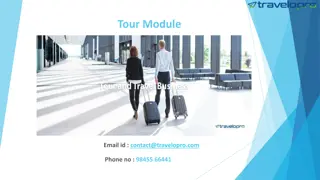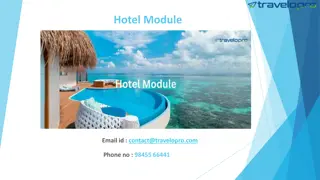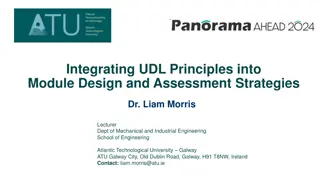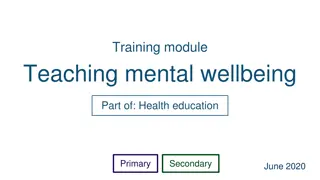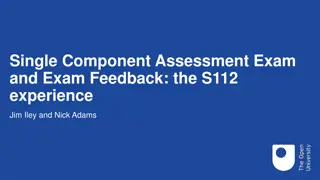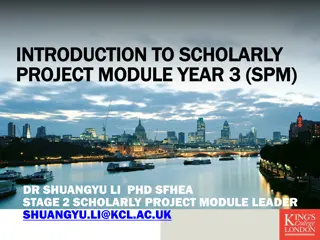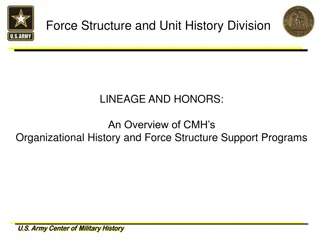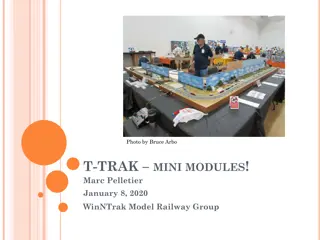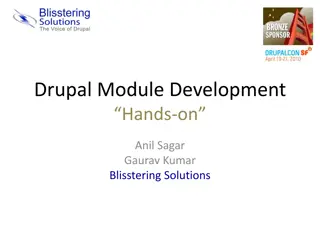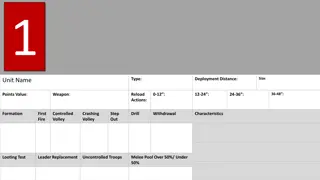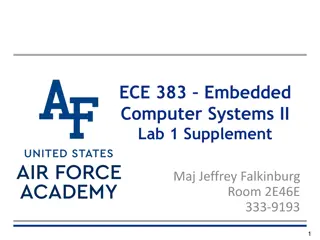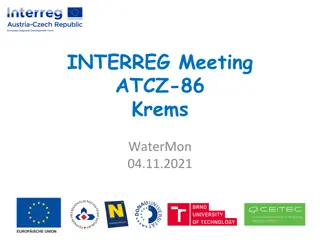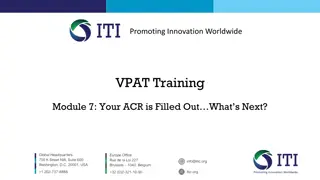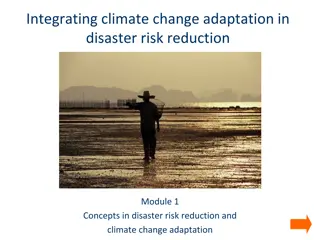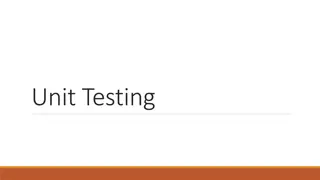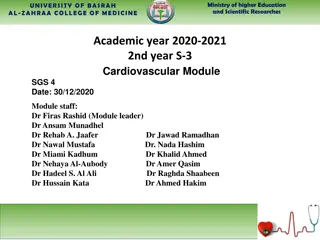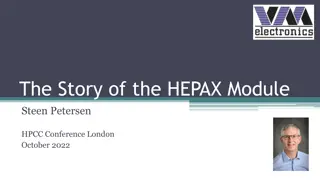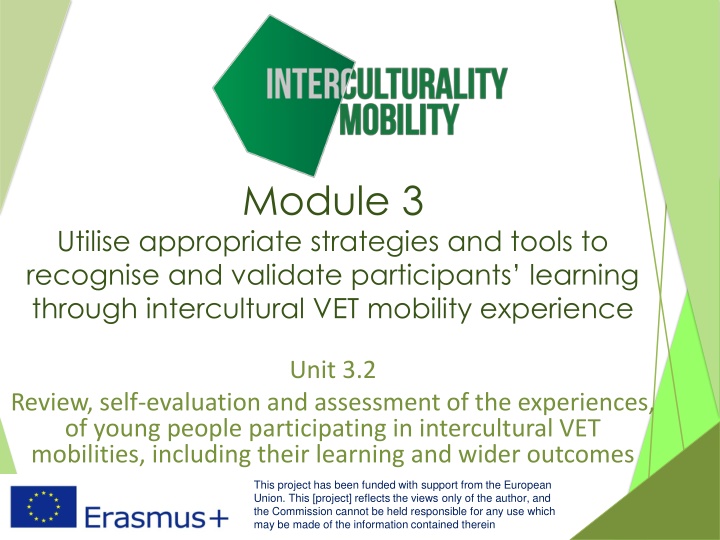
Enhancing Intercultural VET Mobility Learning
Explore tools and strategies to review, self-evaluate, and assess young participants' experiences in intercultural VET mobilities, focusing on learning outcomes and personal development. Learn ways to support reflective learning and enhance the impacts of non-formal learning through effective evaluation processes.
Download Presentation

Please find below an Image/Link to download the presentation.
The content on the website is provided AS IS for your information and personal use only. It may not be sold, licensed, or shared on other websites without obtaining consent from the author. If you encounter any issues during the download, it is possible that the publisher has removed the file from their server.
You are allowed to download the files provided on this website for personal or commercial use, subject to the condition that they are used lawfully. All files are the property of their respective owners.
The content on the website is provided AS IS for your information and personal use only. It may not be sold, licensed, or shared on other websites without obtaining consent from the author.
E N D
Presentation Transcript
Module 3 Utilise appropriate strategies and tools to recognise and validate participants learning through intercultural VET mobility experience Unit 3.2 Review, self-evaluation and assessment of the experiences, of young people participating in intercultural VET mobilities, including their learning and wider outcomes This project has been funded with support from the European Union. This [project] reflects the views only of the author, and the Commission cannot be held responsible for any use which may be made of the information contained therein . Co-funded by the Erasmus+ Programme of the European Union
MODULE 3 UNIT 2 Module title Utilise appropriate strategies and tools to recognise and validate participants learning through intercultural VEY mobility experience Unit title Review, self-evaluation and assessment of the experiences, of young people participating in intercultural VET mobilities, including their learning and wider outcomes Learning objectives To enable practitioners and organisations to enhance the support provided to participants in intercultural VET experiences To help learners to be reflective and able to identify achievements, personal goals, changes and personal development from being in a different cultural context. To enable practitioners and organisations to enhance the impacts of non-formal learning on participants through a clear assessment process and effective follow-up. To construct and conduct a quality assurance procedure in order to facilitate evaluation and assessment Training hours 3 hours (plus online activities for the whole module) Co-funded by the Erasmus+ Programme of the European Union
UNIT CONTENT Tools for recording learners achievements Tools for helping learners modify their behaviour Twenty first century skills revisited Assessment processes from evaluation to accreditation Assembling a portfolio of evidence of learning Understanding criterion referenced assessments Co-funded by the Erasmus+ Programme of the European Union
TIME FOR ACTIVITY ACTIVITY NUMBER: 3.2.2 ACTIVITY TITLE: Following up and evaluating learning gained in non-formal and informal contexts ACTIVITY DURATION: 20 minutes COMMENTS: Co-funded by the Erasmus+ Programme of the European Union
Learner reflection and self-evaluation Young people taking part in intercultural experiences will encounter new people, places and situations, some of which may provide useful and lasting learning experiences. It is important that they maximise the possible benefits to be gained, by maximising their understanding of their new experiences. Co-funded by the Erasmus+ Programme of the European Union
Preparing for an intercultural mobility In unit 2.3 we considered a tool to assist young people with documenting experiences that they find surprising, upsetting, very pleasing of significant in some other way whilst on an intercultural mobility. In unit 3.1 we considered how VET providers could develop tools to assist young people with documenting their attitudes to preparing for participating in a mobility programme. Co-funded by the Erasmus+ Programme of the European Union
Preparing for an intercultural mobility In unit 3.1 we also considered a tool to assist young people with documenting how easy they found it to deal with situations they were likely to encounter during a mobility. We will now introduce another tool which is designed to help learners who are finding a particular cultural phenomenon personally challenging. It is important to capture all situations where there is a new learning experience, however challenging, because such situations can provide great potential for personal growth and therefore for accrediting more learning. Co-funded by the Erasmus+ Programme of the European Union
The DISCo Steps Stretch Tool Produced by the University of Warwick in the UK, this tool can be used DURING a mobility. See https://warwick.ac.uk/fac/soc/al/globalpad/openhouse/interculturalskills/globalpad_stret ch.pdf What is different about the way in which this tool could both support and document learners development? It is designed to change behaviour not just document it How might the DISCo Steps Tool assist your organisation in mapping the learning and development of young people on an intercultural mobility? Co-funded by the Erasmus+ Programme of the European Union
The DISCo Steps Stretch Tool Because it is a journal-type tool, this means that much of the data it produces is descriptive rather than evaluative. For this reason it is helpful to use more than one type of assessment tool to determine the extent to which a learner has developed. In this way, VET assessors make comparisons more easily with attainment levels achieved in informal learning situations. Co-funded by the Erasmus+ Programme of the European Union
TIME FOR ACTIVITY ACTIVITY NUMBER: 3.2.3 ACTIVITY TITLE: Criterion referenced assessment ACTIVITY DURATION: 30 minutes COMMENTS: Co-funded by the Erasmus+ Programme of the European Union
Criterion referenced learning You are going to do a BARRIER ACTIVITY Work in pairs, preferably with colleagues from your own organisation. Label yourselves. One of you is A and one is B. You will receive a passage to read. Make sure that your partner DOES NOT SEE IT!! To help with this, you may prefer to sit back to back, or erect a barrier between you. Co-funded by the Erasmus+ Programme of the European Union
Dont let your partner see your reading passage! sit back to back OR erect a barrier between you Co-funded by the Erasmus+ Programme of the European Union
Criterion referenced learning Read through your passage carefully. The topic is the same as your partners, but the text is a little different. You should take turns to ask each other questions. Use the information in your passage to ascertain if your partner s answers are correct. If you are not sure, ask your own probing questions until you are satisfied. Make a note of the answer your partner gives. When the trainer asks you, compare answers. Co-funded by the Erasmus+ Programme of the European Union
Criterion referenced learning VET organisation develops criteria for assessment Now, both work with your partner to explain the main ideas about criterion referenced assessment and its features in a diagrammatic way. It can be a flow chart, mind map, storyboard or another type of diagram. Criteria shared with learners in a variety of workplaces Assessment takes place more transparently more fairly Learners develop critical thinking skills Co-funded by the Erasmus+ Programme of the European Union
Break Co-funded by the Erasmus+ Programme of the European Union
TIME FOR ACTIVITY ACTIVITY NUMBER: 3.2.4 ACTIVITY TITLE: Twenty first century skills revisited ACTIVITY DURATION: 30 minutes COMMENTS: Co-funded by the Erasmus+ Programme of the European Union
Twenty-first century skills Twenty-first century skills are those which relate not only to personal development, but also vocational qualifications. In unit 2.3, we ranked a number of them in terms of their importance for our learners. This is also a useful exercise for learners to complete, as the extent to which they have developed each skill, can be measured and contribute to a final portfolio for gaining a qualification. Co-funded by the Erasmus+ Programme of the European Union
The Valley Project We are grateful to our colleagues from the Valley Project who have produced a system for evaluating a volunteer s competence in a range of skills. Learners are assessed from three different perspectives: their knowledge (les connaissances) their abilities (les capacit s) their attitudes or behaviours (attitudes) Co-funded by the Erasmus+ Programme of the European Union
The Valley Project How could a format like this assist your learners with assessing skills, personal development and learning acquired in an intercultural context? Co-funded by the Erasmus+ Programme of the European Union
Le livret de comp tences Le livret de comp tences is not based on twenty-first century skills. It does, however, set out a comprehensive list of competencies which are based on the European Key Competences for Lifelong Learning that we first encountered in unit 2.1. It is not currently downloadable so ask the trainer if you would like a copy. Co-funded by the Erasmus+ Programme of the European Union
TIME FOR ACTIVITY ACTIVITY NUMBER: 3.2.5 ACTIVITY TITLE: Incorporating knowledge of informal assessment systems into programme planning and design ACTIVITY DURATION: 30 minutes COMMENTS: Co-funded by the Erasmus+ Programme of the European Union
Taking the next step Learners will accumulated a variety of skills and competences in their home country and during the intercultural mobility. VET organisations and practitioners will have devised systems for assessing and recording this learning, gained in informal and non-formal settings. VET organisations and practitioners must now consider how data collected by the assessments they have devised can be aligned with nationally recognised standards. In this way, learning can be validated against local and national benchmarks and eventually against European benchmarks. Co-funded by the Erasmus+ Programme of the European Union
ASDAN ASDAN is a third sector organisation based in the UK which also awards qualifications at a national level. You will be given some examples of ASDAN assessment systems to illustrate how competences, such as those designed by the Valley Project, or the 21 Century Skills we considered in Module 2, can be elaborated into an evaluative system, aligned to national qualifications. Co-funded by the Erasmus+ Programme of the European Union
ASDAN We are using the ASDAN example because: its courses are well known for providing engaging courses that offer personalised learning and choice, focusing on core skills such as teamwork, communication, problem- solving, research and self-management. they are also well known for successfully mapping the progression of educationally disadvantaged learners, like the learners targeted by this Intercultural Mobility Project. ASDAN programmes lead to qualifications at the national level, which has parity with EQF. Co-funded by the Erasmus+ Programme of the European Union
Handout1_CoPE.pdf Take a few moments to read through this learner s portfolio. Work in pairs to identify: the task that has been set and the steps involved to complete it three 21 century skills that the learners have applied to fulfil the task, e.g team work, time management etc. elements of the assessment that involve journalistic processes elements of the assessment that involve evaluative processes elements of the assessment that involve criterion- based evidence Co-funded by the Erasmus+ Programme of the European Union
Handout1_CoPE.pdf Discuss: How does this assessment process relate to the way in which informal learning is assessed by your organisation? How would your organisation have to adapt current arrangements for assessing learners in order to standardise learner outcomes? Co-funded by the Erasmus+ Programme of the European Union
Handout2_provsolv.pdf This is taken from the ASDAN problem solving module. Compare the levels 1 and level 3 guidance and identify: the difference in the knowledge, skills and techniques required by the two levels the changes in learner outcomes the differences in assessment criteria to be demonstrated as evidence that the learning has taken place Co-funded by the Erasmus+ Programme of the European Union
Handout2_provsolv.pdf Each learning outcome is a rich task involving a mixture of activities, knowledge and skills. It uses criterion referenced assessment to measure personal developmental skills within practical contexts. In your groups discuss: How might VET organisations and their mobility partners change or improve the development of graduated, structured tasks and assessments that add value to learners experiences and work towards meeting national standards? For more information see: https://www.asdan.org.uk/courses/courses-for-your- setting/post-16 Co-funded by the Erasmus+ Programme of the European Union
TIME FOR ACTIVITY ACTIVITY NUMBER: 3.2.6 ACTIVITY TITLE: Further reading, self-assessment and reflection ACTIVITY DURATION: 10 minutes COMMENTS: Co-funded by the Erasmus+ Programme of the European Union
Further Reading Auto valuation_valley.pdf. Available shortly from http://www.intercultural- mobility.eu/en/home/ Livret de comp tences , Association ADICE Co-funded by the Erasmus+ Programme of the European Union
Self assessment and reflection Use the self-evaluation and reflection form to summarise your thoughts on the learning from this session. Co-funded by the Erasmus+ Programme of the European Union
Congratulations! You have completed this unit This project has been funded with support from the European Union. This [project] reflects the views only of the author, and the Commission cannot be held responsible for any use which may be made of the information contained therein . Co-funded by the Erasmus+ Programme of the European Union


